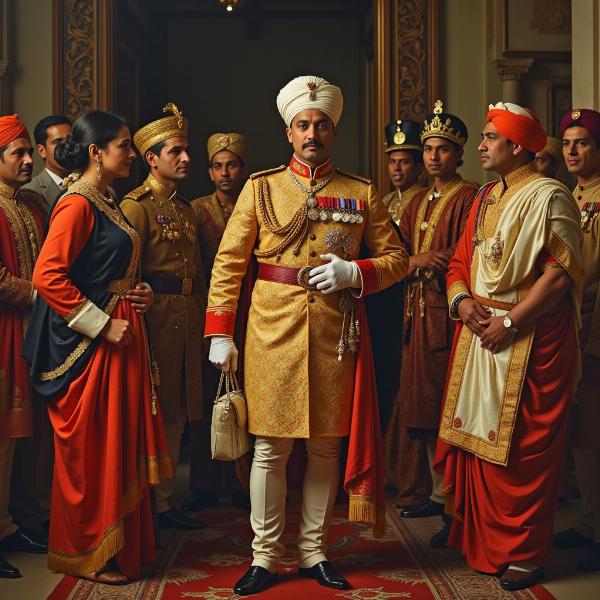Understanding the Hindi meaning of viceroy is crucial for anyone studying Indian history or interested in the nuances of the Hindi language. Viceroy, a term deeply intertwined with India’s colonial past, represents a powerful figurehead and a complex period in the nation’s narrative. This article delves into the various Hindi translations of viceroy, their historical context, and their cultural significance.
Unpacking the Term: Viceroy in Hindi
The most common Hindi translation of viceroy is वायसराय (vāysarāy). This term is a direct phonetic transliteration of the English word, reflecting the historical influence of British rule. However, वायसराय doesn’t fully capture the cultural weight and implications of the title. Other terms like गवर्नर जनरल (gavanar janaral), meaning Governor-General, and राजप्रतिनिधि (rājapratinidhi), meaning representative of the king, were also used, albeit less frequently. These alternatives offer a more nuanced understanding of the viceroy’s role as the highest-ranking official representing the British crown in India. Each term carries its own connotations, reflecting the evolving political landscape and the changing perceptions of British authority.
 Viceroy of India during the British Raj
Viceroy of India during the British Raj
The Historical Significance of the Viceroy
The office of viceroy in India was established in 1858, following the Sepoy Mutiny of 1857. This marked a significant shift in British governance, transferring power from the East India Company directly to the British Crown. The viceroy became the embodiment of British imperial power, wielding immense political and administrative control. From Lord Canning, the first viceroy, to Lord Mountbatten, the last, each viceroy left an indelible mark on India’s history. Their decisions shaped the country’s political, economic, and social fabric, influencing everything from infrastructure development to education policy.
Exploring Related Terms: Nawab, Colonial Government, and the Imperial Legislative Council
Understanding the role of the viceroy necessitates exploring related terms such as nawab, colonial government, and the Imperial Legislative Council. The nawab meaning in hindi refers to a Muslim ruler or nobleman, often holding significant power within specific regions of India. The interaction between the viceroy and the nawabs was crucial for maintaining British control and navigating the complexities of Indian society. Similarly, understanding the colonial government meaning in hindi provides further context for the viceroy’s authority. The viceroy headed the colonial government, overseeing its intricate bureaucracy and implementing British policies. The imperial legislative council meaning in hindi also played a vital role, acting as a legislative body under the viceroy’s authority.
Delving Deeper into the Viceroyalty
The viceroyalty was more than just a title; it represented a complex administrative system with far-reaching consequences. The viceroy’s decisions impacted millions of lives, shaping the destiny of a nation. From implementing land reforms to managing famines, the viceroy’s responsibilities were immense. Studying the viceroyalty provides a deeper understanding of British rule in India, its impact on Indian society, and the legacy of colonialism.
“The viceroyalty was a crucible of power, a position that demanded both political acumen and cultural sensitivity,” notes Dr. Anika Sharma, a renowned historian specializing in British India.
Viceroy: A Symbol of Colonial Power
The term viceroy, in both English and its Hindi translations, symbolizes the complexities of colonial power. It represents the imposition of foreign rule, the intricacies of cross-cultural interactions, and the lasting impact of empire. Understanding the hindi meaning of viceroy offers a glimpse into a pivotal period in Indian history, a period marked by both oppression and transformation.
Conclusion
The Hindi meaning of viceroy encompasses a rich tapestry of historical, political, and cultural significance. From the phonetic transliteration वायसराय (vāysarāy) to the more nuanced terms like गवर्नर जनरल (gavanar janaral) and राजप्रतिनिधि (rājapratinidhi), each translation offers a unique perspective on this powerful figurehead. Understanding the viceroy’s role, the associated terminology, and the historical context is crucial for comprehending the complexities of British rule in India and its lasting legacy. This knowledge not only enriches our understanding of the past but also informs our perspective on the present.
FAQ
- What is the most common Hindi word for viceroy? The most common Hindi word for viceroy is वायसराय (vāysarāy).
- When was the office of viceroy established in India? The office of viceroy was established in 1858.
- Who was the first viceroy of India? Lord Canning was the first viceroy of India.
- What is the meaning of राजप्रतिनिधि (rājapratinidhi)? राजप्रतिनिधि (rājapratinidhi) means representative of the king.
- Why is understanding the Hindi meaning of viceroy important? Understanding the Hindi meaning of viceroy provides insights into India’s colonial past and the nuances of the Hindi language.
- What other terms are associated with the viceroy? Related terms include nawab, colonial government, and the Imperial Legislative Council.
- Where did the viceroy reside in India? The viceroy resided in the Viceroy’s House, now known as Rashtrapati Bhavan, in Delhi.
Meaning-Hindi.in is your trusted partner for accurate and culturally sensitive Hindi translations. We offer a range of specialized translation services, including business and legal document translation, technical and educational material translation, website localization, and lansdowne meaning in hindi. Contact us at [email protected] or +91 11-4502-7584 for all your Hindi translation needs. Meaning-Hindi.in is committed to delivering high-quality translations that bridge language barriers and foster understanding.